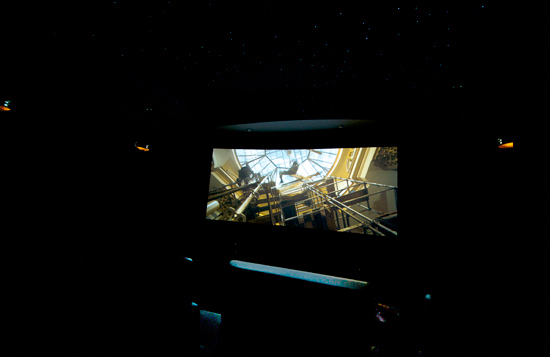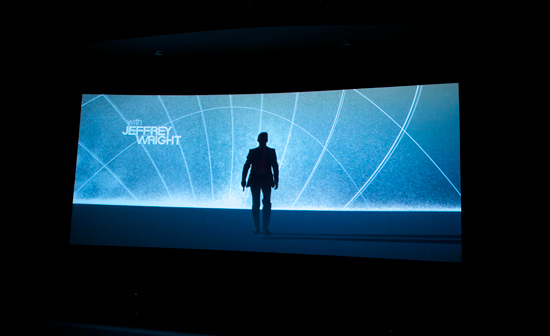Zotac's Ion: The World's First mini-ITX Ion Board
by Anand Lal Shimpi on May 12, 2009 12:00 AM EST- Posted in
- GPUs
Zotac’s Ion in My Theater
Last year I spent a lot of time building a home theater. All content is played back on my HTPC running Windows Vista Media Center along with MyMovies (to catalog my library) and VMC Media Browser to tidy up the interface. The hardware is composed of an ATI Radeon HD 4550 as well as an Intel Core 2 Quad Q9650. The result works pretty well. I wanted to see how close the Zotac Ion could get to my setup.
With an external power supply I didn’t have to do much, I just grabbed the Zotac board and the power brick, set the two on top of my equipment rack and plugged it in. I immediately appreciated the silence of the Zotac, as quiet as I’ve made my HTPC, it’s still not totally silent. That doesn’t usually matter while I’m watching a movie, but whenever I pick the seat closest to the equipment rack it irks me a bit (similar to how you can always notice even the most minor scratches on your car).
Actual video playback wasn’t an issue, the Zotac board already passed all of my Blu-ray tests if you’d remember. And I rip all of my content so CPU usage never even went beyond 20%. What I wanted to know was how well the Zotac board could handle navigating through my library, the VMC menus, etc...
I for sure thought that the Atom was too slow to serve as a real HTPC. Sure you could watch movies on it, but actually navigating through your library using a pretty UI - no way.
I must admit, I was pleasantly surprised.

Quantum of Solace - 1080p - 11' screen - all powered by Zotac's Ion

The Zotac Ion was by no means fast at navigating through the Media Browser interface, but it was acceptable. Scrolling through tens of movies is a bit painful, make it hundreds and you may want to consider a faster CPU, but it wasn’t nearly as bad as I expected.

The VMC Media Browser interface, slow, but usable on the Ion
During playback I could pause, skip forward and adjust volume without dropping any frames. The Ion worked as a real HTPC doing real duty. I was impressed. Pair it up with a TB hard drive and you have a great way of watching your content on your TV or projector. Use a NAS and you can even keep all the noise out of your theater room.
Performance aside, remember that this is a GeForce 9300 we’re talking about here. I had a single HDMI cable going to my receiver which carried 1080p video, DD or DTS 5.1 audio or 8-channel LPCM if I decided to let my machine do all of the decoding. I didn’t test CPU utilization on the latter due to time constraints but I plan to in the near future.










93 Comments
View All Comments
nubie - Tuesday, May 12, 2009 - link
Assuming the price is under $180 for the LGA 775 board that would be my choice.You can passively cool a Celeron 420, 430 or 440 and pick one up for $25-30 on ebay. The Conroe-L will absolutely murder the Atom for any gaming or encoding, and most of them will bump to 1066 without a voltage increase.
The 775 board is $139 with free shipping.
http://www.newegg.com/Product/Product.aspx?Item=N8...">http://www.newegg.com/Product/Product.aspx?Item=N8...
Throw an e5200 or Celeron DualCore at it and just laugh at the Ion platform trying to keep up.
Don't forget the PCI-e 2.0 x16 slot so you can game too if you want.
My choice is pretty clear, forget ION for the desktop unless you really need one of the features (DC power, ultra-low consumption, just can't afford the extra $20-40) the LGA 775 is the better choice for future-proofing an ITX platform. And chances are you have the CPU and heatsink laying around (I know I do.)
If they can get a 32nm Desktop processor at 15-20 watts (for the CPU) instead of that Atom I would love to see it.
strikeback03 - Wednesday, May 13, 2009 - link
I'm not sure I would call anything on LGA 775 future-proofing, as all the processors we are going to see for that socket are now out. So yes performance would be better than Ion, but it would still be a system with almost no room to upgrade.nubie - Thursday, May 14, 2009 - link
I meant future-proofing as in "allowing the platform to remain viable into the foreseeable future." And in comparison with the Atom board it is infinitely future-proof (X16 PCI-e 2.0 and an LGA socket will do that.)You can't argue that a 3.0ghz Quad core won't work adequately for the next 5 years on any conceivable OS, whereas this Atom processor is struggling even now.
Not to mention the PCI-e 2.0 x16 slot, what happens when the 9300 doesn't cut it anymore? The Atom platform has no room for upgrade.
If they cost the same when you outfit the LGA 775 motherboard with a Celeron (and the celeron is much faster), with the option down the road of a dual or quad core and any video card you want, I would say in comparison to the Atom board it is future-proofing.
strikeback03 - Thursday, May 14, 2009 - link
If power consumption is a concern though, you won't ever be using a Penryn quad-core. Due to the memory controller it is highly unlikely any motherboards from the Penryn era will be usable with future processors, so for low power usage an Atom board now and something else low power in a year or two is more likely the way to go.dEad0r - Tuesday, May 12, 2009 - link
Why are there different versions of that platform?Today Computerbase released their review of the "Zotac IONITX-A", which features the same CPU, but offers the faster Nvidia 9400 graphics card onboard.
So all the gaming benchmarks should be way better.
http://www.computerbase.de/artikel/hardware/mainbo...">http://www.computerbase.de/artikel/hard...dia_ion/...
As you can see, for World in Conflict, Doom 3, F.E.A.R. and Company of Heroes are fully playable at 1024x768 1xAA/1xAF, as the ION gives us ~30 fps in those tests.
JarredWalton - Tuesday, May 12, 2009 - link
Don't get too carried away: the 9400 runs at 580/1400MHz core/shader clocks while the 9300 runs at 450/1200MHz core/shader clocks. Assuming games aren't bottlenecked by memory bandwidth, the 9400 is about 20% faster - so it could equal the X800 XT.Those benchmarks you link show the GeForce 9400 as being around six times faster than the 945G chipset, which is quite similar to the results Anand shows in WoW. I'm guessing that the details are set to low or medium in order to get many of those games to 5-6FPS with the GMA 950.
Pirks - Tuesday, May 12, 2009 - link
when you have this: http://www.newegg.com/Product/Product.aspx?Item=N8...">http://www.newegg.com/Product/Product.aspx?Item=N8...sprockkets - Tuesday, May 12, 2009 - link
Because that board is crap compared to the Intel LGA board in the article.It lacks a x16 pci-e slot, wifi isn't built in, needs laptop ram and has no optical or coax audio out. Plus, Linux easily supports PureVideo; no such tech I know of for Ati. While this does feature more SATA ports, I can live without that.
And you rather pay $20 more for that?
Visual - Wednesday, May 13, 2009 - link
dude, the atom mini itx boards also don't have pci-express 16x. intels have a pci just like this amd, the ion one has mini-pci-e which is just 1x and it is ment to be used with the bundled wireless card - it will be quite hard to find other devices for it.where did you get that 16x from?
sprockkets - Thursday, May 14, 2009 - link
Are you capable of looking at the specs yourself of the LGA board in the article?Or, look here: http://www.newegg.com/Product/Product.aspx?Item=N8...">http://www.newegg.com/Product/Product.aspx?Item=N8...
I accept your apology Pirks.